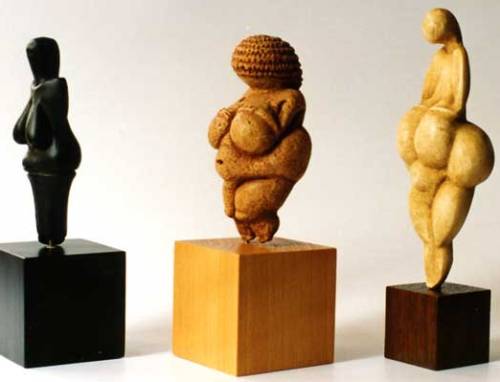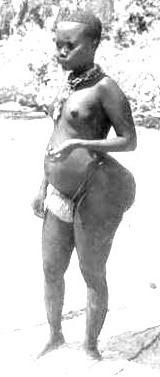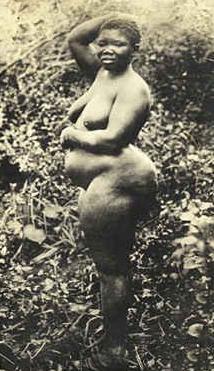Bigfoot’s Steatopygia
Posted by: Loren Coleman on September 18th, 2007
Everyone talks about Bigfoot breasts, but aren’t we ignoring another rather significance part of the filmed Bigfoot body?
In a forthcoming Fall 2007 issue of TAPS Paramagazine I examine in detail the never or little discussed theory that the female “Patterson Bigfoot” shows steatopygia, which by definition is the extreme accumulation of fat on the buttocks.
In anticipation of the publication of my thoughts on that matter, here are some visuals to examine during the month leading up to the 40th anniversary of the filming of Bigfoot at Bluff Creek, California, which occurred on October 20, 1967. They are archival anthropological photographs that demonstrate examples of steatopygia in Homo sapiens – contemporarily and through archaeologically discovered art.
What do you think?
Shown in ancient cave art:

For modern females among the Onge/Bushman, Hottentot, and Andamanese Negrito:




And with a Bushman male:

Finally, an apparent female Bigfoot (freeze frames of the buttocks occur in the last 1/3 of the footage here):
About Loren Coleman
Loren Coleman is one of the world’s leading cryptozoologists, some say “the” leading living cryptozoologist. Certainly, he is acknowledged as the current living American researcher and writer who has most popularized cryptozoology in the late 20th and early 21st centuries.
Starting his fieldwork and investigations in 1960, after traveling and trekking extensively in pursuit of cryptozoological mysteries, Coleman began writing to share his experiences in 1969. An honorary member of Ivan T. Sanderson’s Society for the Investigation of the Unexplained in the 1970s, Coleman has been bestowed with similar honorary memberships of the North Idaho College Cryptozoology Club in 1983, and in subsequent years, that of the British Columbia Scientific Cryptozoology Club, CryptoSafari International, and other international organizations. He was also a Life Member and Benefactor of the International Society of Cryptozoology (now-defunct).
Loren Coleman’s daily blog, as a member of the Cryptomundo Team, served as an ongoing avenue of communication for the ever-growing body of cryptozoo news from 2005 through 2013. He returned as an infrequent contributor beginning Halloween week of 2015.
Coleman is the founder in 2003, and current director of the International Cryptozoology Museum in Portland, Maine.










I think you are onto something there. I’m all for getting to the ‘bottom’ of this mystery. Who would have thought we could tell so much from some Bigfoot booty?
I don’t think that could have been faked so easily with a suit. Why would anyone go to all that bother?
I think that the concept of steatopygia might have some relevance with actual sasquatch sightings (such as those detailed in in “Raincoast Sasquatch,” and even eyewitness illustrations also, if memory serves).
But I will draw the line with the Patterson-Gimlin film. I have brought this up before in earlier response commentary with other sasquatch-related threads that Loren has posted here.
I think, with the prevailing evidence, that the P-G film is not real. I draw all readers’ attention to the book “Meet the Sasquatch” by Christopher Murphy et. al. On pages 53, and 54, there are a series of high quality stills (that actually begin on page 52), and one can see that in frames 339, 352, and 362, as well as 364 that something is dreadfully “un-natural” about the creature’s posterior. It shows non-symmetry, it shows what can be interpreted as a “butt pad” that is not conforming to the person inside the suit. (One can even interpret fur artifacts that indicate “under the suit strapping” to keep the butt pad in place that goes onto the waist and upper thigh area in the stills. This is definitely not seen in any hirsuite pongids in nature. Not ever, as far as I know.) This is most spectacularly evident and glaring in frame 339 on page 53 of Murphy’s book, but one can see this in the subsequent frames that are printed in the book. What I am pointing out are details that point to the notion that this is not an authentic representation of a real primate’s posterior.
That doesn’t mean that the issue discussed in this thread may not be relevant. I am saying that the film in question is not evidence of a bipedal, North American primate unknown to science. And I feel cannot be used as evidence for comparatory efforts, or any other reason.
But I am very grateful to Christopher Murphy, and his colleagues for presenting these stills in clear, large, published form. They are of great value to all researchers, I would think.
My opinion, my two cents.
I’m curious as to why steatopygia evolved as a physical attribute in humans. What is the evolutionary advantage? Perhaps the ability to store fat for times when food is scarce? Why particularly in females? Sexual selection? I would think it would be easier to get around with a large butt in an open grassland like in Africa, as opposed to heavily wooded areas where bigfoot is supposed to live. In African hunter/gatherer cultures that exhibit steatopygia, aren’t the women a lot more stationary (taking care of the children, digging for roots, etc)? If so, why don’t we come across female bigfoot and their babies more often?
I must say that this is truly one of the most illuminating takes on the film that I’ve seen, from such a fresh angle that, yes, it provides a whole new obstacle for nay-sayers (suit-sayers) to overcome. Why has nobody done this before? Thanks, Loren, for this extremely potent contribution.
Are we certain it’s fat we’re looking at on Patty? I’ve assumed it was muscle.
Wouldn’t the compliant gait, large body mass, and need to cover irregular terrain tend to produce impressive musculature there?
I never noted that before, it looks like the close up was doctered for you tube?
Interesting topic, something worth investigating further.
Now, tongue in cheek, I wonder if Sir Mix-a-Lot would be willing to investigate. 🙂
So Patty has a big butt. I noticed that the first time I saw the video. It looks normal for her. Now some of those photos just don’t look normal. Take the 4th one for instance. You probably can’t get a more real photo. But man, there is something about that one that gives me the ebeejeebees. Almost looks like, man I don’t know what. Anyway, I agree that Patty’s butt is more muscle than fat.
fmurphy1970: “get to the bottom of this mystery” – nice one!
I have read some accounts that Sasquatch could be omnivorous.
If they do indeed eat meat, having a lot of muscles in the glute area could be a distinct advantage in hunting certain kinds of prey. If you have ever noticed a deer trail (for instance), they go up hills in a serpentine manner. Bears, which have incredibly powerful hindquarters, will chase a deer straight up a hill. If Patty’s big ol’ butt is muscle instead of fat, perhaps this is the reason.
Thanks for bearing with me…
/sorry
I typically tend to try not to make too many presumptions about Bigfoot through comparisons with our own physical structure, simply because it is still an unknown. Although the pictures of our own species up there are compelling and show this dramatic buildup of fat is present in our own species, it is not certain just how closely Bigfoot would be related to us and so to me it is not any sort of conclusive proof that the PG film is real. Assuming for a moment the film is real, we still do not know enough about this creature to say whether the buttocks could be caused by this phenomena or not, since we are basing this hypothesis on observations of our own species. Since we do not know for a fact what Bigfoot is, basing too much research upon this might be building a case on potentially flawed data and could lead to inaccurate assumptions. It’s an interesting theory, however, and something definitely worth discussing here, I would say. I’m looking forward to seeing what people here have to say about it.
In addition, fat seems to “bounce” more than muscle does.
In the Patterson Video, Patty’s rear seems to stay pretty much still.
I would presume that if you had video of, say, the Hottentot woman walking at a fast clip, I’d venture that her behind would be jiggling like a bowl of jello.
I say it’s muscle, not fat.
This is good. Some thoughtful comments already.
You will note that the diversity of suggestions here thusfar appears to be in the eye-of-the-beholder, for you can find one person (e.g. dbard) who sees no “bounce” in the posterior of the Bluff Creek Bigfoot – and that being used to justify why that area must be muscle – and yet another individual (e.g. greenmartian2007) finds much evidece of change in the rear end of the Bigfoot – to justify why the film is not real to him/her.
It really does depend on your point of view.
For starters, I wanted people to begin to look at the whole animal here, the entire Bigfoot, and therefore the illustrative exercise of comparing what is seen for the posterior of Bigfoot with the steatopygia in a few humans is a good one. This is a great beginning.
It tells me there is more to learn from this footage, even as it nears it 40th anniversary.
Interesting possibility.
hey loren nice article about bigfoot. i like the above replys as well. good afternoon bill green
steatopygia? Not a chance!
P-G film is not real? Not a chance!
Personally, I think the pictured posteriors aren’t very good matches for the subject on the P/G footage. They look much, much larger (in relation to the rest of the peoples’ bodies) than what Patty is sporting. I think this is a closer match (the original version is sadly now offline, but I managed to find this thumbnail on Google). It appears to be sourced from this picture.
Hmmm. Tricky indeed. In general, animals don’t grow fat like we humans do so I find the muscle theory more likely. The metabolism might be a key here but then we would need to study a bigfoot. An animal of that size does need strong muscles to be able to move swiflty and muscles need protein, The combination of big muscles and signs of bigfoot being rather sharp minded compared to for example bears makes me guess that it is an omnivorous creature. That is if it exists of course. How about our cousins the great apes? Bigfoot seems to be an apelike creature and if the PG film is real it does not walk like a human. Perhaps it would be of use to study the great ape’s lower muscles and construction as well.
From Wikipedia:
How could an hirsute animal use steatopygia as an evolutionary advantage in an environment like woody British Columbia?
Some commenters have mentioned the possibility of Bigfoot being omnivorous, yet the evident sagital crest in Patty is typical of primates who have to deal with a poor protein/high fiber diet, like mountain gorillas, right?
Regarding the film, I used to be 100% convinced. Now I’m more like 30-40% convinced
It’s been a while, Loren, bloggers, and fellow posters.
Well, what a discussion this has turned out to be. While steatopygia in sasquatch is an interesting point to toy with, I have to agree with mystery_man’s position that it’s an adaptive trait found in humans. So far as I’m aware, humans are the only primate in which steatopygia occurs. I have to extend my thanks to red_pill_junkie for pointing out exactly what steatopygia is (saved me from doing so). Given that it’s an adaptation for hot climes, why would it occur in sasquatches?
Kudos to planettom for the Sir Mix-a-Lot reference!
Just my two cents.
Whoops!
…mystery_man’s position that it’s an adaptive trait found in humans and therefore direct comparisons cannot be made to sasquatch, which is clearly a separate species.
My bad.
Something else about the footage strikes me more than steatopygia. It’s the creature’s back. Although not an expert in kinesiology it looks as if Patty suffers from a stiff spine. Its back is rigid and the arms swing separately from the body like the hinged arms of a playmobile toy. I would have expected more flexibility from a wild animal. Has anyone else noticed this? If it is not an illusion I have then this topic deserves its own thread.
Elsanto: Who knows, perhaps Mr. Michaels has been doing some research in this area..
😉
Regarding the stiff back, I believe Gorillas also turn their shoulders when they turn their heads..I can see that in the P/G film, but no real “stiffness” per se.
I have read many reports that mention a fluid arm swing as well.
For what it’s worth..
I’ll even go further with my last post and say that not only is steatopygia a human adaptation, it also seems to be a trait primarily associated with a hot, savanna environment. As some posters have commented here, that leaves the question of why Bigfoot would have or maintain this sort of trait in its current habitat. Even if Bigfoot evolved in such an arid environment, a trait like this would likely not just hang around if there was no benefit from it, which is why it is typically confined to people living in this sort of climate. So by saying that Patty is exhibiting this adaptation, we are not only assuming that sasquatch would have steatopygia to begin with, but that it is defying the usual circumstances under which the characteristic is found which is a hot, arid environment. Still interesting, but that is a lot of jumps for me considering what is known about this trait in humans as well as how little we actually know of sasquatch physiology. I appreciate the visual comparison of Patty to steatopygia in humans, and I won’t rule it out entirely, but superficial similarities are not always a good indicator of actual function.
Hold the presses mystery man and others…don’t believe everything you read in Wikipedia as being complete. Don’t take comments above as complete either.
Before all the various statements here about an arid climate as the origin of steatpygia being taken as fact (because a few people are thinking “Bushmen Hottentot” only), let me say “Whoa!”
For one thing, there are three known human populations that show the trait: Pleistocene humans living in cold Europe and Asia climates; the Khoisan (Bushman, Hottentot) of desert climes; and the Andamanese (Jarawa, Onge) of subtropical rainforests. It is an old genetic trait among at least one form of bipedal primate, and thus it has some possible attractiveness as a point of discussion for Bigfoot.
But first, let me say this clearly: The link between steatopygia and “arid” climates is a myth, as used here to so quickly dismiss Bigfoot as a candidate for having it.
Here’s a few words from anthropologist George Weber on some basics:
That’s certainly interesting info, Loren. Thanks. I am always eager to learn more. I still wonder how much we can surmise about sasquatch based on observations of this condition in humans, though. I can see that since both are bipedal primates, there is merit to the theory and I agree that it is an interesting line of questioning that could lead to shedding light on the PG footage. The fact remains though that we don’t really know just how closely related this creature is to us and any superficial similarities cannot be relied upon too heavily. I just feel that perhaps it would be too hasty to start drawing too many parallels or making assumptions linking humans to a creature we know very little about.
And it is too early to close your mind to any possible overlaps that might exist between the two bipedal primates – the naked apes called humans and the hairy ones called Bigfoot.
If an area of study such as steatopygia has, by acknowledgement, been understudied among Homo sapiens, why would we wish to close the doors on studying whether it is a factor within hominology based on the assumption it is only a Homo sapiens trait?
We have no idea what Sasquatch is, and I submit, there are many mysteries among humans that exist, which may impact on the Sasquatch question too.
I am for keeping any open mind about a variety of avenues of study, and not close it down based upon assumptions – of any kind.
That is a very rational, very valid train of thought, Loren. Thank you for sharing. I am not trying to close down any avenues of inquiry, but rather just expressing my reservations about building too much upon any one theory or other based on a species, us, different from the one we are looking at here, Bigfoot. On top of that, there is the unknown of whether this footage is even real, which in my opinion is something to be kept in mind. I think it could be, be it is not indisputable. To me, assuming the PG footage is real (which it may very well be, but who knows?) and then basing theories and research upon a possibly flawed source is something that should be done with caution. That is not to say I am keeping a close mind to the PG footage or the steatopygia theory expressed here, but rather I am hesitant to base too much on either at this point. After all, in light of concrete evidence to the contrary, saying that the footage is real and that Patty exhibits steaptopygia is as much an assumption as someone saying they are not. Assumptions abound.
You are right that this is all point of view. One person sees lean, well developed muscle, and others see steatopygia, yet we do not even know if this speculation is based on a real video representation of an actual creature, nor what relation that creature may have to us. But you are very right, of course. Right now, with what we know about the sasquatch, pretty much all we really can do in the absence of a body or specimens to study is look to what most closely resembles it and that is us and the great apes. I suppose in the end, it is true we just have to look at different avenues and try to examine each one to the fullest in the hopes of shedding even a little light on the truth. I appreciate the comments from you and the theory you have put forward here.
I can say one thing for sure, and that is this thread has inspired me to want to look into and study up on steatopygia not only because it could pertain to sasquatch, but also because it is an intriguing area that I had never really heard of before. Yet another avenue of study that I have been turned onto by this site. Good stuff.
Hi Loren, I think this “steatopygia” topic is very relevant, even if it’s not the definitive track. And I agree, we shouldn’t refer too quickly to these familiar images that flood our minds. “Bouncing” is not a mandatory. We are talking about a wild animal here, and – if there is – a pretty strong one, whose bottom can be fat and muscled at once.
Let me share with you a special time I’ve had last year with Marie-Jeanne Kauffmann. As you certainly know, this wonderful old lady is a very scientific person. She used to be a surgeon, and worked closed to Boris Porchnev. In spite of forty years on the field in Caucasus, looking for the Almasty (the local name of the wild man), she never had the chance to see one. Only footprints, droppings and hairs. And an amazing amount of first hand accounts by local people. Which is a lot for a few of us. But her scientific training prevents her to validate its existence without a real hard proof or solid personal sighting. If you ask her: “Do you believe in the existence of the Almasty?” She would answer: “Listen, I have found some information that might lead to the idea that there is something out there, but so far I definitely cannot claim that such a creature does exist”.
Last year, I watched with Marie-Jeanne Kauffmann the Patterson film on my computer. She already saw the film years ago, but she was really excited to see it again, a few times in the row, and able to stop where she wanted. It was a great experience to share her comments, as she pointed to me the way the muscles were moving, and other scientific remarks. That was the surgeon who was speaking.
And then she told me: “You know, when I see this film now, I can feel something I couldn’t understand when I was talking at the time with the Caucasian eyewitnesses. They would tell me that Almasty looks like a human being and a wild animal at the same time, awesome by its power and its strength. I couldn’t mix that double information. Now, watching this film, I understand what they meant. In this creature filmed by Patterson, I can see both the human being and the wild animal”.
What a great character! I’ll never forget that day, and it’s my pleasure to share this memory with you.
Interesting input in Steatopygia Mr. Coleman. This is what these discussions should be all about, back and forth info so we can learn more. Thanks.
Still, I agree with mistery-man that caution should be taken regarding reading too much on the Patterson film. If only, because if it’s actually real, then it is only the visualization of ONE specimen, and extrapolating too many characteristics of a species based on the viewing of one individual might not be such a good idea (well at least in my opinion). Especially since Sasquatchs seem to have a lot of traits in common with homo sapiens, and look how diverse we are.
Maybe Patty was just a chubby ape-girl, but that may not be the case with all the Bigfoot ladies 😉
This is ridiculous. It seems an awful lot like throwing epicycles on top of epicycles. Why is this silly little film given so much credit?
This is not the time of Ptolemy, so a cumbersome system of epicycles upon epicycles seems hardly a good analogy for biology. But go ahead and have your fun with cryptozoology.
However, as a skeptic of the film, I say, if one puts no stock in the Patterson-Gimlin footage outright, then please ignore these discussions because you have already made up your mind.
Give some regard for that fact I still consider it possible there may be a young Copernicus out there, and she or he may not have stumbled yet upon the answer.
Remember these creatures run on all fours. They walk bipedially. Large glutes. We will need to catch one alive. I will try to do that very thing.
I have watched this film thousands of times. I have been investigating this and many other cryptid phenomena for decades. I assure you – having lived around animals all my life and being very knowledgeable about mammals since the 60s – the Patterson film is real.
She has large buttocks because she would be very muscular there. She may look different than other known apes because of the habitat.
It is real this film; it also probably was the same animal that caused Roger to go hunt that area from stories from other researchers. She may have had children and was staying in the area for needed water supply or food, perhaps?
I know by the way it walks and by the gait and hand and feet movement, and by way the neck and shoulder turns together.
Tons of phony ape films cannot even scratch the surface of this film.
It proves that we owe a massive debt to Roger and Bob for allowing us to see the last giant North American land mammal undiscovered by science. Thank you for allowing us this pleasure; long live the Sasquatch.
As far as I am concerned, case closed.
Hi I noticed something on the Patterson film link from you site that I never noticed before even though I froze every frame many times the way this person layed it out, it shows mid way in the film a not to be gross but large deep behind crevice, that you actually see muscles inside flexing in the depth of the crack even though this is gross it makes this theory of it being a suit much more unlikely who could of thought of such a deep degree of correctness in suit design in 67 to even include a deep anal area with muscles inside and natural cheek movement it is beyond comprehension and I wish people would finally stop arguing about this film and except it as fact because it all adds up to one conclusion Sasquatch is alive and well in north America .
Steatopygia is worth pursuing as a theory, even though right now I’m leaning a little bit more towards the well-muscled angle. To me, Patty’s back reminds me of a mountain gorilla’s. Any chance someone could post a few good shots of gorilla glutes for comparison?
It is also worth noting that the Khoisan represent one of the oldest lineages of mankind on the planet, which means that they may have retained a few traits that other populations have lost. Which is not to call them primitive in any way. Having a younger lineage does not make anyone better, merely different. Personally, I think the “new kids on the block” could learn a thing or two from their “elders.”
I’ve come to this one late. A few thoughts on distributed body fat and the reasons for it
In human females, fat stored on the buttocks / thighs is much healthier fat than that stored round the abdomen. It can also be much firmer than fat in other areas of the body. – it does not necessarily ‘wobble’ much.
Fat stores food for lean times.
A heavy bipedal human has very, very well developed glute and thigh muscles under all that fat, even if you can’t see them, especially if they’re on their feet and moving a lot. That makes the booty bigger – and firmer. I’d expect the same in any bipedal animal
It makes sense for an animal / human living in a highly seasonal area, where food is not equally available all year round, to store excess fat.
Does sasquatch, or did it ever, hibernate? Or go into a ‘slowdown’ mode during times of cold.
Do other mammals in similar environments store fat, if so why and where on their bodies.
I speak as someone who neither accepts or rejects that particular film. But, alas, I have much experience of the storage of fat and the underlying musculature… 😉